2022.5.8 请求重定向与转发 base标签
请求重定向
请求重定向,是指客户端给服务器发请求,然后服务器告诉客户端去新地址访问。叫请求重定向(之前的地址可能已经被废弃)。
一个web资源(B)收到客户端A请求后,B会通知客户端A去访问另外一个web资源C,这个过程叫重定向
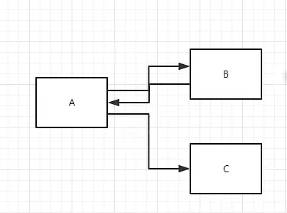
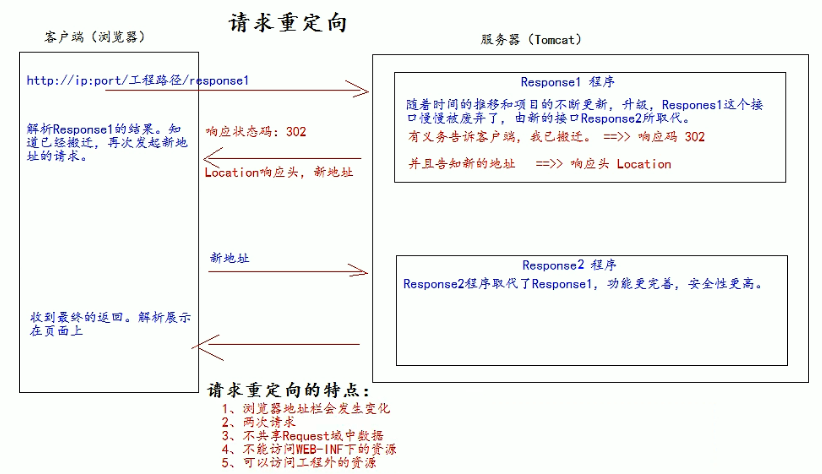
Response1
1 package com.xing.servlet; 2 3 import javax.servlet.ServletException; 4 import javax.servlet.http.HttpServlet; 5 import javax.servlet.http.HttpServletRequest; 6 import javax.servlet.http.HttpServletResponse; 7 import java.io.IOException; 8 9 public class Response1 extends HttpServlet { 10 11 @Override 12 protected void doGet(HttpServletRequest req, HttpServletResponse resp) throws ServletException, IOException { 13 System.out.println("曾到此一游 Response1 "); 14 15 req.setAttribute("key1", "value1"); 16 //法一 17 // 设置响应状态码302,表示重定向 18 // resp.setStatus(302); 19 // 设置响应头,说明新的地址在哪里 参数形式 类似map 将Location设置为http://localhost:8080/07_servlet/response2 20 // resp.setHeader("Location", "http://localhost:8080/07_servlet/response2"); 21 // resp.setHeader("Location", "https://www.baidu.com/");//可以重定向到工程外的资源 22 23 //法二 24 resp.sendRedirect("http://localhost:8080/07_servlet/response2");//resp.sendRedirect("/07_servlet/response2"); 25 } 26 }
1 package com.xing.servlet; 2 3 import javax.servlet.ServletException; 4 import javax.servlet.http.HttpServlet; 5 import javax.servlet.http.HttpServletRequest; 6 import javax.servlet.http.HttpServletResponse; 7 import java.io.IOException; 8 9 public class Response2 extends HttpServlet { 10 11 @Override 12 protected void doGet(HttpServletRequest req, HttpServletResponse resp) throws ServletException, IOException { 13 System.out.println(req.getAttribute("key1")); 14 //新的业务逻辑 15 resp.getWriter().write("response2's result!"); 16 } 17 }
web.xml
1 <?xml version="1.0" encoding="UTF-8"?> 2 <web-app xmlns="http://xmlns.jcp.org/xml/ns/javaee" 3 xmlns:xsi="http://www.w3.org/2001/XMLSchema-instance" 4 xsi:schemaLocation="http://xmlns.jcp.org/xml/ns/javaee http://xmlns.jcp.org/xml/ns/javaee/web-app_4_0.xsd" 5 version="4.0"> 6 7 <servlet> 8 <servlet-name>Response1</servlet-name> 9 <servlet-class>com.xing.servlet.Response1</servlet-class> 10 </servlet> 11 <servlet-mapping> 12 <servlet-name>Response1</servlet-name> 13 <url-pattern>/response1</url-pattern> 14 </servlet-mapping> 15 <servlet> 16 <servlet-name>Response2</servlet-name> 17 <servlet-class>com.xing.servlet.Response2</servlet-class> 18 </servlet> 19 <servlet-mapping> 20 <servlet-name>Response2</servlet-name> 21 <url-pattern>/response2</url-pattern> 22 </servlet-mapping> 23 24 </web-app>
访问:http://localhost:8080/07_servlet/response1
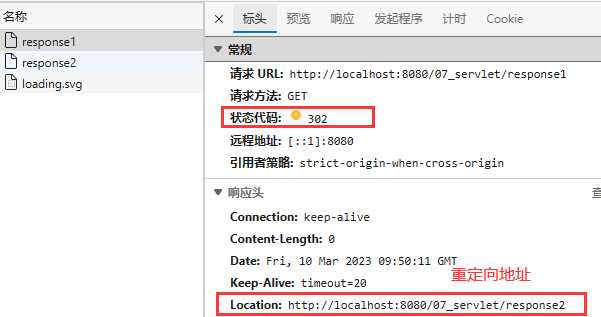
请求的转发
什么是请求的转发(相当于呼叫转移)?

请求转发是指服务器收到请求后,从一个资源跳转到另一个资源的操作叫请求转发。
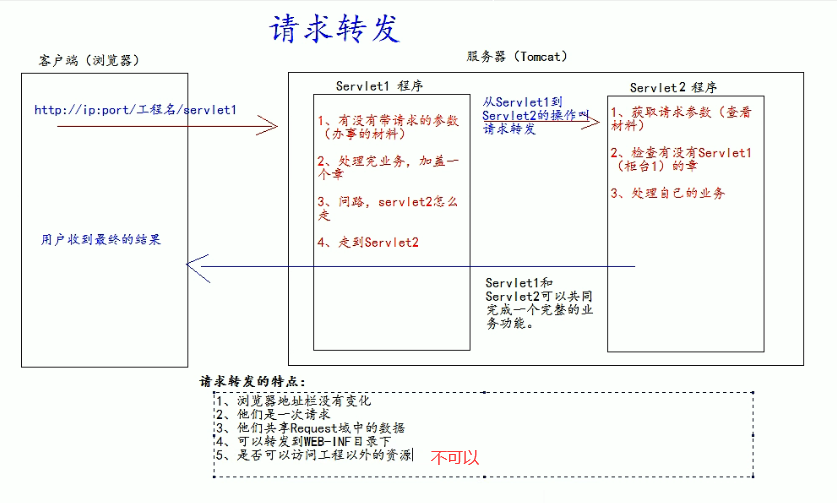
测试1:
Servlet1
1 package com.xing.servlet; 2 3 import javax.servlet.RequestDispatcher; 4 import javax.servlet.ServletException; 5 import javax.servlet.http.HttpServlet; 6 import javax.servlet.http.HttpServletRequest; 7 import javax.servlet.http.HttpServletResponse; 8 import java.io.IOException; 9 10 public class Servlet1 extends HttpServlet { 11 @Override 12 protected void doGet(HttpServletRequest req, HttpServletResponse resp) throws ServletException, IOException { 13 14 // 1.获取请求的参数(办事的材料)查看 15 String username = req.getParameter("username"); 16 System.out.println("在Servlet1(柜台1)中查看参数(材料):" + username); 17 18 // 2.给材料 盖一个章,并传递到Servlet2(柜台 2)去查看 19 req.setAttribute("key1","柜台1的章"); 20 21 // 3.问路:Servlet2(柜台 2)怎么走 22 23 // 请求转发必须要以斜杠打头,/ 斜杠表示地址为:http://ip:port/工程名/ , 映射到IDEA代码的web目录 转发到哪里 24 RequestDispatcher requestDispatcher = req.getRequestDispatcher("/servlet2"); 25 26 //4.走向Sevlet2(柜台 2) 进行转发 27 requestDispatcher.forward(req,resp); 28 29 } 30 }
Servlet2
1 package com.xing.servlet; 2 3 import javax.servlet.ServletException; 4 import javax.servlet.http.HttpServlet; 5 import javax.servlet.http.HttpServletRequest; 6 import javax.servlet.http.HttpServletResponse; 7 import java.io.IOException; 8 9 public class Servlet2 extends HttpServlet { 10 @Override 11 protected void doGet(HttpServletRequest req, HttpServletResponse resp) throws ServletException, IOException { 12 // 1.获取请求的参数(办事的材料)查看 13 String username = req.getParameter("username"); 14 System.out.println("在Servlet2(柜台2)中查看参数(材料):" + username); 15 16 // 2.查看 柜台1 是否有盖章 17 Object key1 = req.getAttribute("key1"); 18 System.out.println("柜台1是否有章:" + key1); 19 20 // 3.处理自己的业务 21 System.out.println("Servlet2 处理自己的业务 "); 22 } 23 }
web.xml
1 <?xml version="1.0" encoding="UTF-8"?> 2 <web-app xmlns="http://xmlns.jcp.org/xml/ns/javaee" 3 xmlns:xsi="http://www.w3.org/2001/XMLSchema-instance" 4 xsi:schemaLocation="http://xmlns.jcp.org/xml/ns/javaee http://xmlns.jcp.org/xml/ns/javaee/web-app_4_0.xsd" 5 version="4.0"> 6 7 <servlet> 8 <servlet-name>Servlet1</servlet-name> 9 <servlet-class>com.xing.servlet.Servlet1</servlet-class> 10 </servlet> 11 <servlet-mapping> 12 <servlet-name>Servlet1</servlet-name> 13 <url-pattern>/servlet1</url-pattern> 14 </servlet-mapping> 15 16 17 <servlet> 18 <servlet-name>Servlet2</servlet-name> 19 <servlet-class>com.xing.servlet.Servlet2</servlet-class> 20 </servlet> 21 <servlet-mapping> 22 <servlet-name>Servlet2</servlet-name> 23 <url-pattern>/servlet2</url-pattern> 24 </servlet-mapping> 25 26 </web-app>
访问 localhost:8080/07_servlet/servlet1?username=xiaoming 传了参数,参数为xiaoming

测试2:
请求转发可以转发到WEB-INF目录下
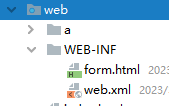
1 package com.xing.servlet; 2 3 import javax.servlet.RequestDispatcher; 4 import javax.servlet.ServletException; 5 import javax.servlet.http.HttpServlet; 6 import javax.servlet.http.HttpServletRequest; 7 import javax.servlet.http.HttpServletResponse; 8 import java.io.IOException; 9 10 public class Servlet1 extends HttpServlet { 11 @Override 12 protected void doGet(HttpServletRequest req, HttpServletResponse resp) throws ServletException, IOException { 13 14 String username = req.getParameter("username"); 15 System.out.println("在Servlet1(柜台1)中查看参数(材料):" + username); 16 17 req.setAttribute("key1","柜台1的章"); 18 RequestDispatcher requestDispatcher = req.getRequestDispatcher("/WEB-INF/form.html"); 19 //RequestDispatcher requestDispatcher = req.getRequestDispatcher("http://www.baidu.com"); //不可以 相当于访问 http://localhost:8080/07_servlet/http://www.baidu.com 20 21 //4.走向WEB-INF/form.html 22 requestDispatcher.forward(req,resp); 23 24 } 25 }
base 标签的作用

index.html
1 <!DOCTYPE html> 2 <html lang="zh_CN"> 3 <head> 4 <meta charset="UTF-8"> 5 <title>首页</title> 6 </head> 7 <body> 8 这是Web下的index.html <br/> 9 <a href="a/b/c.html">a/b/c.html (用a标签直接跳到c.html)</a><br/> 10 11 <a href="http://localhost:8080/07_servlet/forwardC">请求转发:a/b/c.html(利用servlet程序的请求转发 跳到c.html)</a><br/> 12 <a href="/">斜杠</a> 13 </body> 14 </html>
c.html
1 <!DOCTYPE html> 2 <html lang="zh_CN"> 3 <head> 4 <meta charset="UTF-8"> 5 <title>Title</title> 6 </head> 7 <body> 8 这是a下的b下的c.html页面<br/> 9 <a href="../../index.html">跳回首页</a><br/> 10 </body> 11 </html>
ForwardC
1 package com.xing.servlet; 2 3 import javax.servlet.ServletException; 4 import javax.servlet.http.HttpServlet; 5 import javax.servlet.http.HttpServletRequest; 6 import javax.servlet.http.HttpServletResponse; 7 import java.io.IOException; 8 9 public class ForwardC extends HttpServlet { 10 @Override 11 protected void doGet(HttpServletRequest req, HttpServletResponse resp) throws ServletException, IOException { 12 System.out.println("经过了ForwardC程序"); 13 req.getRequestDispatcher("/a/b/c.html").forward(req, resp); 14 } 15 }
web.xml
1 <?xml version="1.0" encoding="UTF-8"?> 2 <web-app xmlns="http://xmlns.jcp.org/xml/ns/javaee" 3 xmlns:xsi="http://www.w3.org/2001/XMLSchema-instance" 4 xsi:schemaLocation="http://xmlns.jcp.org/xml/ns/javaee http://xmlns.jcp.org/xml/ns/javaee/web-app_4_0.xsd" 5 version="4.0"> 6 7 <servlet> 8 <servlet-name>ForwardC</servlet-name> 9 <servlet-class>com.xing.servlet.ForwardC</servlet-class> 10 </servlet> 11 <servlet-mapping> 12 <servlet-name>ForwardC</servlet-name> 13 <url-pattern>/forwardC</url-pattern> 14 </servlet-mapping> 15 16 </web-app>
访问http://localhost:8080/07_servlet/index.html

测试1:点击 a/b/c.html (用a标签直接跳到c.html) 跳转到

点击跳回首页可以跳回首页
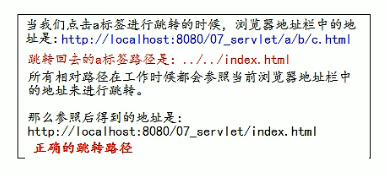
测试2:点击 请求转发:a/b/c.html(利用servlet程序的请求转发 跳到c.html) 跳转到

点击跳回首页不可以跳回首页
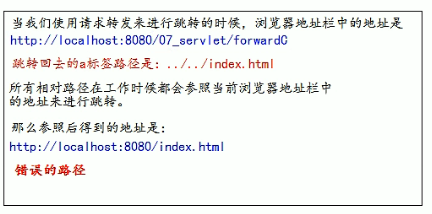
解决方法:base标签
c.html
1 <!DOCTYPE html> 2 <html lang="zh_CN"> 3 <head> 4 <meta charset="UTF-8"> 5 <title>Title</title> 6 <!--base标签设置页面相对路径工作时参照的地址 7 href 属性就是参数的地址值 8 --> 9 <base href="http://localhost:8080/07_servlet/a/b/c.html"> 10 <!-- 最后的c.html 可以不写 因为不是文件夹 11 <base href="http://localhost:8080/07_servlet/a/b/"> 12 --> 13 14 </head> 15 <body> 16 这是a下的b下的c.html页面<br/> 17 <!--会相对base标签进行跳转 这种相对路径都是基于base标签进行的(这个是基本base目录回退两级),有时候会出现问题,一般不用--> 18 <a href="../../index.html">跳回首页</a><br/> 19 </body> 20 </html>




 浙公网安备 33010602011771号
浙公网安备 33010602011771号